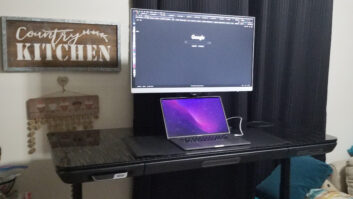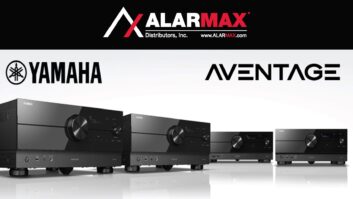Hewlett-Packard is using the launch of its next-generation digital entertainment center to tie together consumer electronics product lines while building new opportunities for profitability in traditional consumer electronics distribution channels, said Jan-Luc Blakborn, HP’s U.S. consumer digital entertainment cross category manager.
Blakborn, who gave private demonstrations of the digital entertainment center to select dealers during September’s CEDIA Expo, said HP is launching its new lines of entertainment-based products — which include plasma and LCD flat-panel TVs, DLP home theater projectors, iPODs and new digital entertainment centers — through its “better” PC retail partners and with select audio/video specialty chains, including Tweeter, J&R, The Good Guys, Nebraska Furniture Mart, BrandsMart, P.C. Richard & Son, American TV and Fry’s.
The company is looking to have the new lines positioned in electronics sections separately from its PC IT product lines.
“Our entry with plasmas and LCDs was a starting point [for CE retail distribution],” Blakborn said. “We are entering the channel using a controlled scale. For our retail partners, we have chosen to go primarily with smaller regional CE players in order to start out on a somewhat smaller scale, so we can learn all of the nuisances of the CE channel. That way, as we start scaling up our business next year, we will have some experience under our belts.”
The company’s better IT/PC accounts will also see the new products, including such powerful chains as Best Buy, Circuit City and CompUSA. It also just announced signing D&H Distributing and DDI as distributors to handle smaller IT and CE accounts.
Blakborn said HP will not look to build a market in CE using PC marketing practices, adding that there is no plan to undercut margins currently enjoyed in the CE channel to buy market share. But HP is attempting to offer attractively priced home-theater display products by adapting its own inkjet printing technologies to create high-resolution images at lower cost.
“The fundamentals of the PC business are separate from the fundamentals of the CE business,” Blakborn said. “We don’t come to the table to drive out profitability. We come to the table to create new opportunity, and because of that we will create new profitability.
“We will be working closely with our retail partners. So far, the traditional CE players have been more responsible for driving down the prices of flat-panel TVs than the traditional PC players,” he said.
Some of HP’s new CE retail partners have enthusiastically embraced HP’s digital entertainment direction. Blakborn said some of those smaller retailers have taken it upon themselves to merchandise HP-branded entertainment products together in focused merchandising areas. He said HP is not directing such efforts yet, but may consider them as it scales up its distribution program.
Similarly, HP plans to expand the HP brand image to encompass its new consumer electronics lines, by running a brand awareness ad campaign somewhat slowly this year and gradually expanding to meet its expanded distribution base next year, Blakborn said.
The recent introduction of HP’s digital entertainment centers using Microsoft’s latest media-center operating system was viewed as the linchpin in HP’s plans to build a CE product family.
All of HP’s previously announced CE products will seamlessly interface with the entertainment-centric PCs, which are designed to look like traditional home theater components instead of desktop computers. HP has even developed “bridge” software to help the Apple iPods in its line work smoothly and seamlessly with the Digital Entertainment Center functions.
“Our goal is to provide complete entertainment solutions, by adding IT technologies behind the traditional consumer electronics experience,” said Blakborn.
“Our digital entertainment center is what [HP’s CEO] Carly Fiorina had referred to previously as an ‘entertainment hub,’” he said. “We have designed our system so you can put the hub and our displays together using more traditional IT technologies such as wireless networks, aided by a user-friendly interface, which allows you to easily send pictures, music and videos anywhere in your home.”
Although HP offers high-definition displays in its initial line, the digital entertainment centers do not support high-definition digital video recording or tuning. However, Blakborn said, HD capability is in the roadmap for future digital entertainment center generations.
Unfortunately, the NTSC-only versions were designed for simplicity of use and low maintenance, and do not offer plug-and-play upgrading capability like traditional desktop PCs. So users desiring high-definition tuning and high-definition digital video recording will have to purchase a new unit, or connect them to separate HDTV cable or satellite decoder boxes.
If problems do arise, HP is offering 24-hour/seven-day per week tech support via the Web and recently developed its “Total One” warranty program, which allows HP customers to bring all of their warranties under one warranty package.
As for its overall business, Blakborn said HP is using partnerships to make HP fit into the entire entertainment chain, from content creation to distribution to consumption.
“We are helping to transform pieces of the total entertainment chain by working closely with partners,” he said.
Blakborn pointed to HP’s partnership with DreamWorks, which is using HP servers and mass data storage systems to produce films like “Shrek.”
HP has also partnered with Starbucks by setting up a “concept store” in California where customers can drink a latte while creating, burning and purchasing custom music CDs using HP tablet PCs, containing thousands of songs and cover art.
On the hardware side, HP has partnered with Apple to sell its popular iPod hard-drive music players in the HP line.
As for video displays, Blakborn said HP is utilizing its patents from its printing and imaging business, to develop superior image quality in more affordable digital TVs.
“This year we are in the market with front-projection, plasma and LCD displays. We will broaden the range of products next year throughout the whole projection category, including rear-projection as well.













